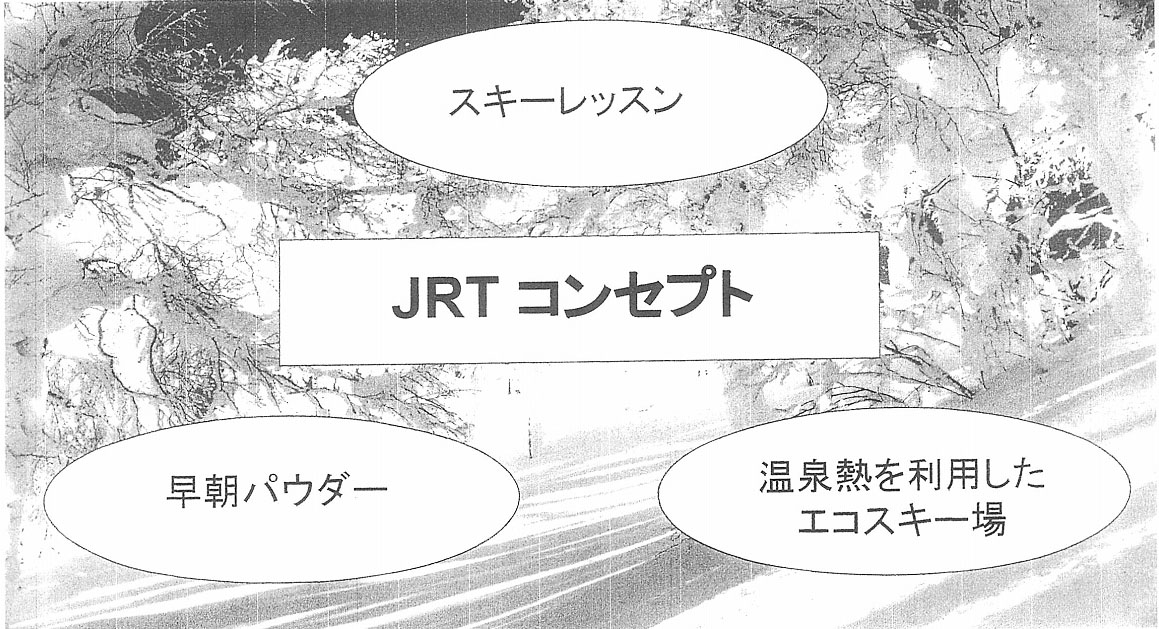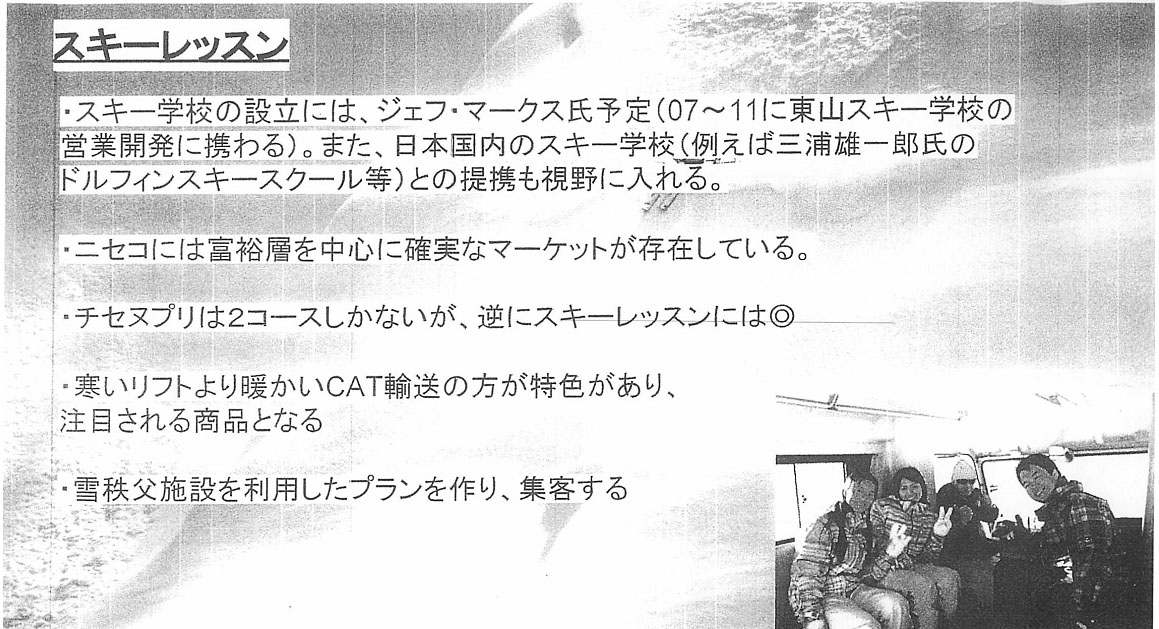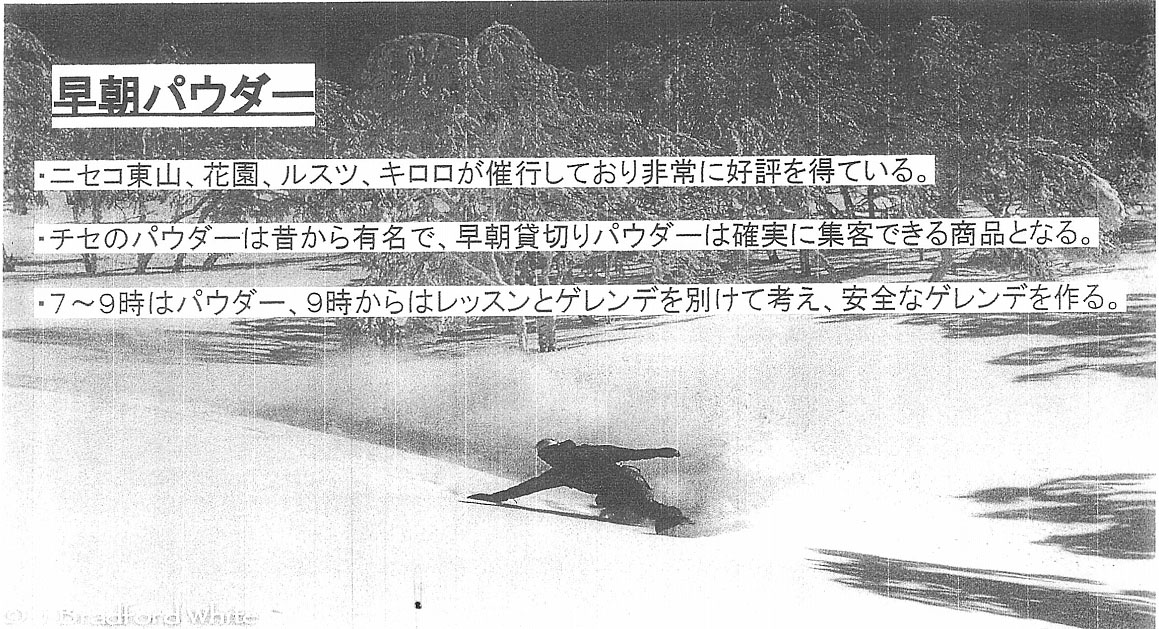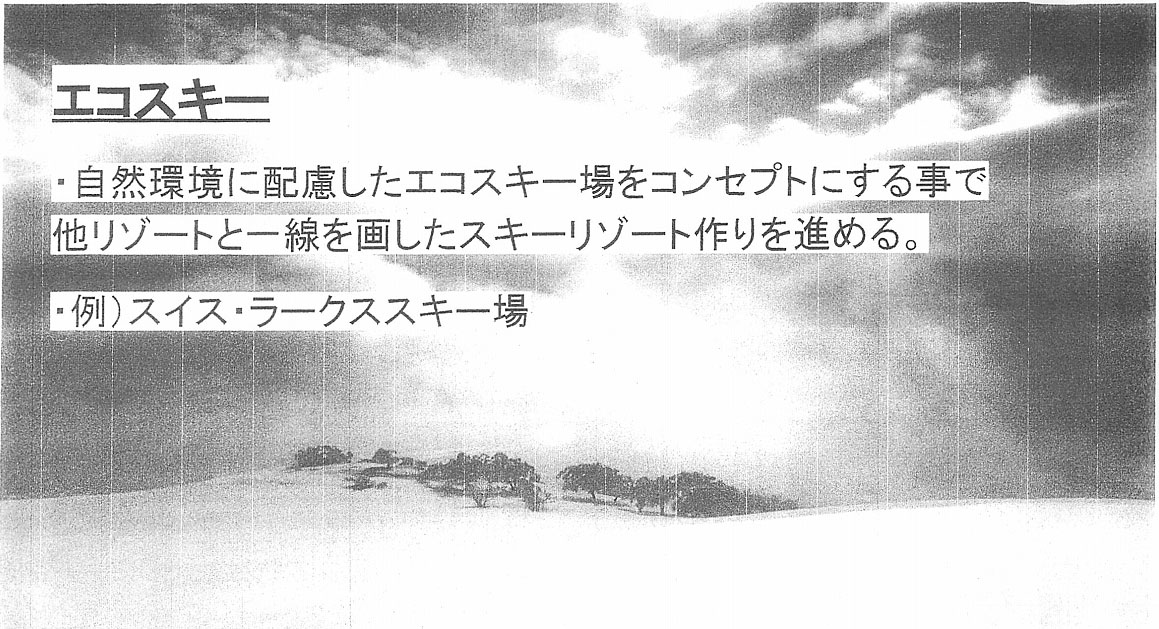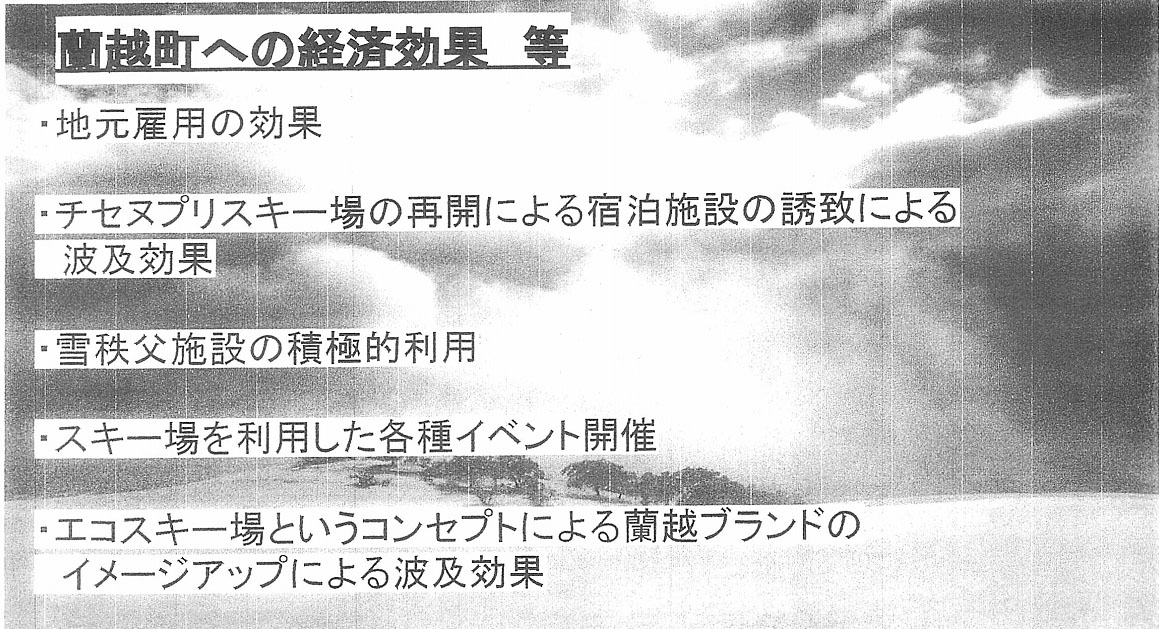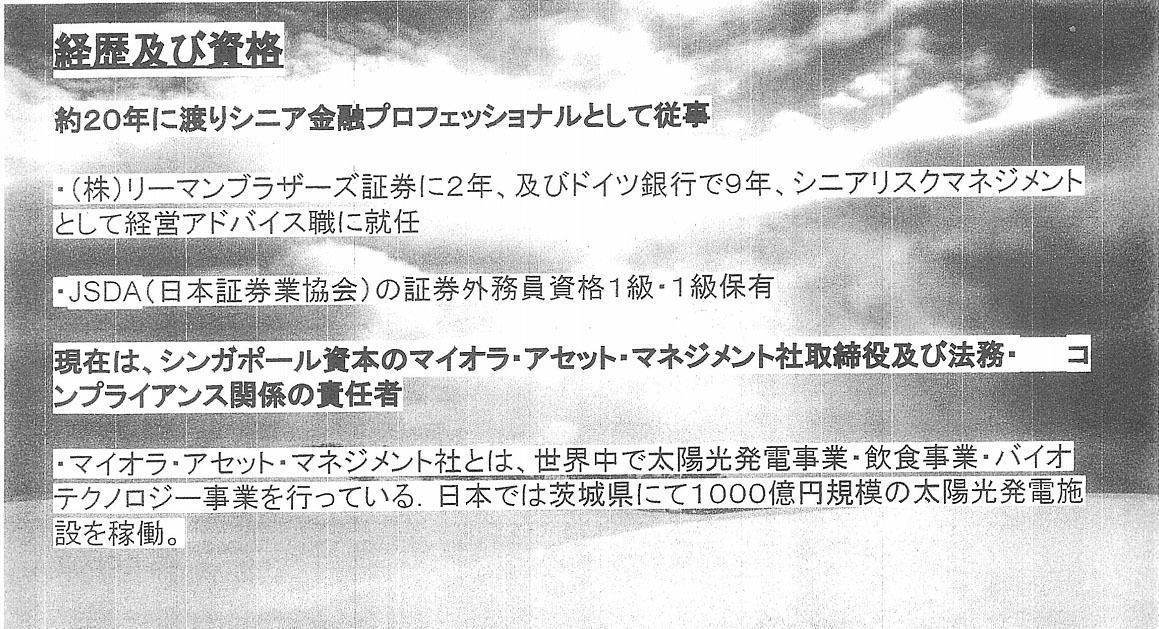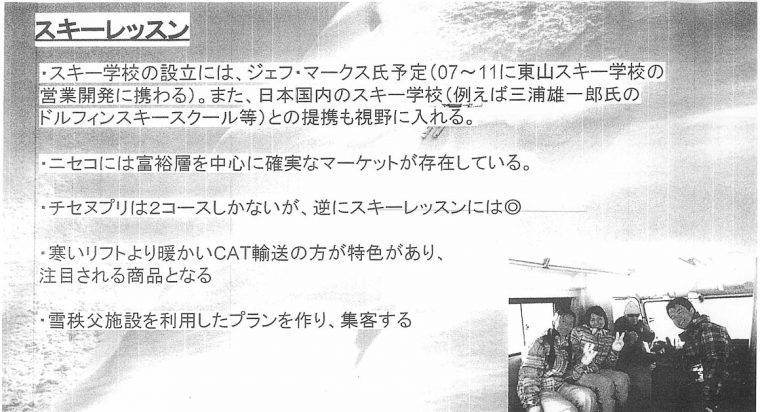Prologue
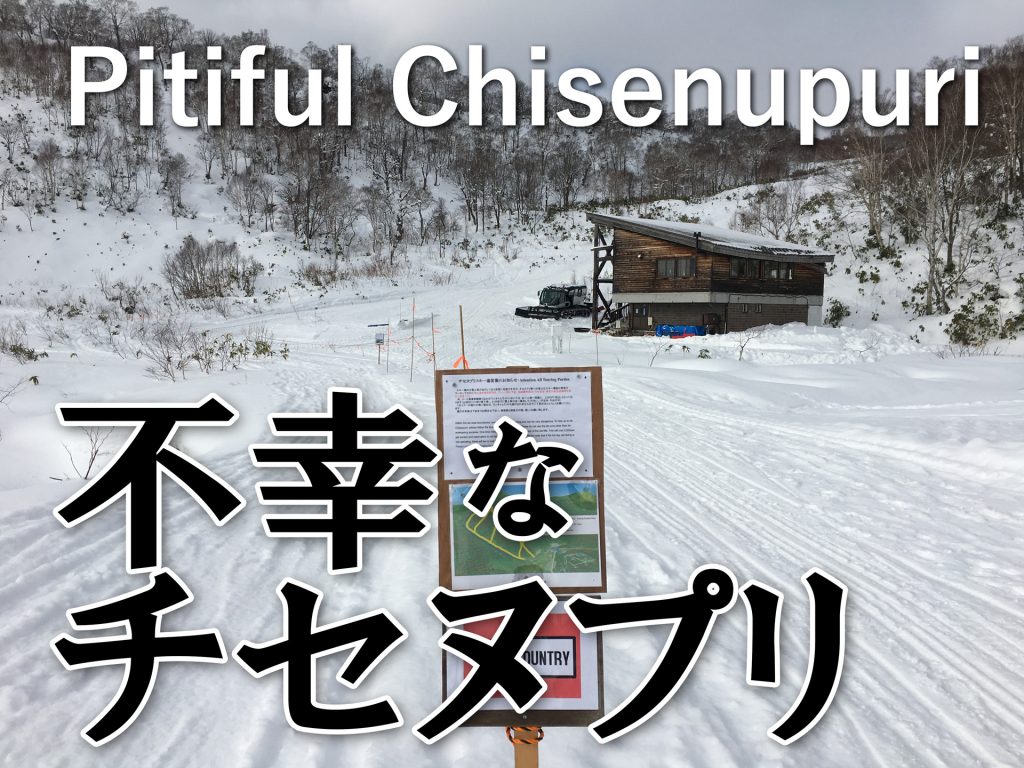
The Chisenupuri ski facilities was closed in 2013 and sold in 2016. In addition, Rankoshi-cho is not subject to the resumption of lift when sold, and the conditions are not stated in the sales contract. The purchased company (JRT Trading) has begun sales of CAT skis that use snow vehicles instead of lifts.

The Chisenupuri Ski Area is the entrance to the route that runs vertically through the Niseko Mountains, and many backcountry skiers use the slopes of the Chisenupuri Ski Area. The problem is that JRT Trading (hereinafter “JRT”) excludes non-CAT ski users.
When the lift was working, skiers bought one-time ticket and went out to the backcountry. However, the CAT ski runs by JRT is based on a charter plan that is limited to 16 people per day, and the charge is 33,150 yen per person (19-20 season). There is no doubt that the target is the wealthy.
JRT prohibited skiers other than CAT ski users from entering the ski slope. The reason is as follows: “* CAT are always running and it is very dangerous”.
Complaints about the exclusive use of the JRT also reached me who lived in the town. So when I interviewed Rankoshi-cho, the deputy mayor answered. According to the deputy mayor, the town has received several complaints. However, I did not receive the impression that the deputy mayor took it seriously.
In addition, Rankoshi-cho sold four items: lift, lift terminals, rest house, and warehouse. About 286,424.13 square meters, which is the site of the ski slopes, JRT takes over the land lease right and pays the land lease fee of 900,000 yen per year to Hokkaido, the owner.
The issues I want to raise in this article are:
- Validity of when and how Rankoshi Town sold the facility
- Validity of exclusive operation of JRT
- Can JRT resume lift?
The history of Chisenupri Ski Area
In the days without lift, skiing meant backcountry skiing. In 1910-1912, Lieutenant Lerhi instructed skiing in Japan. In Hokkaido, ski members from Hokkaido University and Otaru Higher Commercial School (now Otaru University of Commerce) enjoyed skiing at the Niseko Mountain Range. This is the origin of skiing in Hokkaido. At the same time, Niseko began as a snow resort.
At that time, skiers headed backcountry by bus or on foot from Konbu Station or Kaributo Station (now Niseko Station). The inns around the Konbu Onsen(昆布温泉), Kokutetsu Yama-no-ie(国鉄山の家), Yumoto Onsen(湯本温泉), etc. were used as inns.

A lift was installed in 1967 on the slopes near Chise House to the midde of Chisenupuri. That is the Chisenupuri Ski Area.
The Chisenupri Ski Area is an important place for backcountry skiing as it is the starting point for going through the Niseko Mountains.
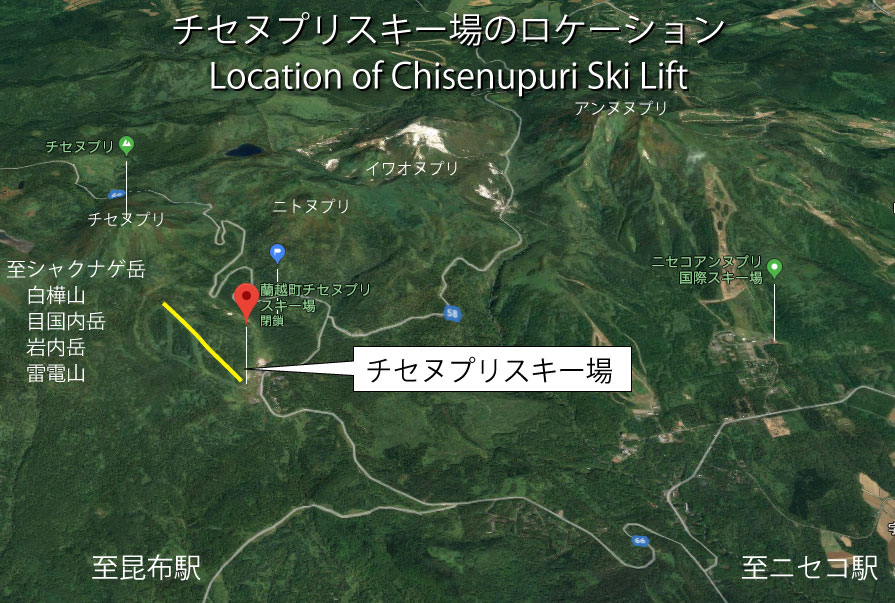
However, Rankoshi-cho, who owned this ski facilities, sold it for only 10 million yen.
How it was sold
| 1967 | Started lift operation as an incidental facility for National lodging Yukichibu (雪秩父) |
| 1991 | Renovated with private donation |
| 2013 | Lift operation stopped due to aging |
| 2013 | 7466 ski slopes users submitted a petition requesting the continuation of the ski lift |
| 2014 | Rankoshi-cho started to prepare for sale it |
| 2015 | Rankoshi-cho set the selling price to 50 million yen |
| 2016 Mar | The sale amount was reduced to 10 million yen, and a new public offering was started.。PDF showing open call for participants |
| 2016 Oct | the contract was executed |
Rankoshi-cho has chosen JRT Trading Co., Ltd., whose main business is ski tours.
Materials submitted by JRT Trading to Rankoshi-cho
Sales Condition
The reason why Rankoshi-cho sells the Chisenupuri Ski facilities is described in “Application for Approval Consultation on Transfer of Destination Public Offering” as follows. This application is a document addressed to Hokkaido, which owns the land.
The Chisenupri Ski Slopes opened in December 1967 in order to make use of the tourism resources of the Yumoto area, which has a historical background, and then, in 1991, established a two-seater hooded high-speed lift, Although we have continued operations, the number of ski lift users has declined year by year, peaking at 164,464 in 1991, and dropped to about 80,000 in 2011.
On the other hand, repair and maintenance costs due to the aging of lift facilities and the effects of sulfur have been increasing year by year, so we have been considering measures such as renovation of facilities including safety measures by stopping lift operation since 2013. While we have, because it does not stand the prospect of securing financial resources, continue, we also plan to rest in 2015.
At such circumstances, a sign that asked for the continuation of the ski resort was submitted by the mountain skiing enthusiasts to the town and the town council. And as a result of examining the future of Chisenupri Ski Slopes, if it is possible to continue the ski resort with a new private management sense, it is judged that it would be the best measure from the aspect of tourism promotion and regional revitalization in Rankoshi. So Rnkoshi-cho decided to sell Chisenupri Ski facilities to any private enterprise.
Although unprecedented economic boom
The following table is a graph attached to the materials for sale.
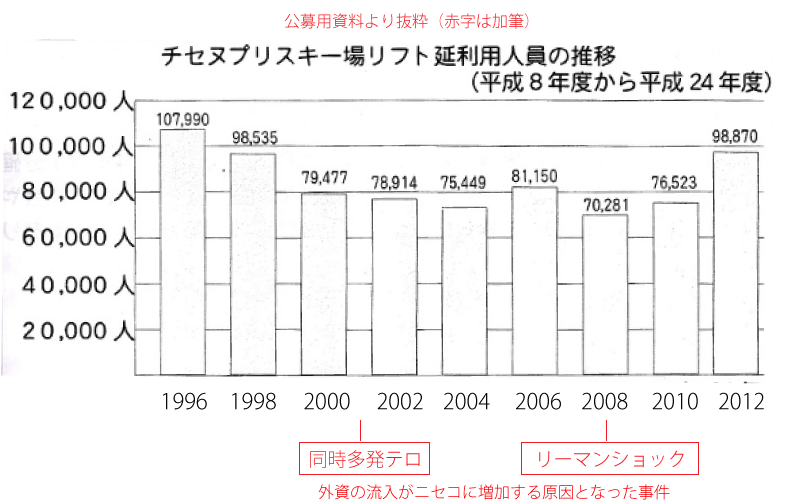
The following graph shows changes in the number of guests in Kutchan-cho, Niseko-cho, and Rankoshi-cho. With the exception of Rankoshi-cho, where there are few lodging facilities, the increasing trend of guests is clear.
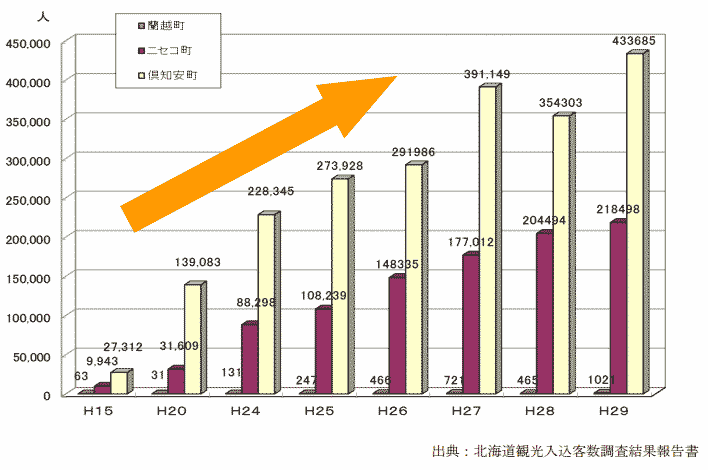
次に、エリアのニュース年表を示す。
| 1994 | Niseko Adventure Center was Established. |
| 1998 | NISEKO UNITED All Mountain Pass started. |
| 2001 | Due to the terrorist attacks, low-risk Niseko began to attract attention from Australian tourists. |
| 2004 | Tokyu sells the HANAZONO course to a foreign company and at the same time acquires the Alpine ski resort. |
| 2007 | Land price in Kutchan-cho began to record the highest rate in Japan. |
| 2008 | Niseko Village is acquired by YTL capital. |
| 2015 | HANAZONO Resort announced Hyatt Hotel’s Management. YTL announced Marionette Hotel’s Management. |
It’s 2014 that Rankoshi-cho decided to sell the ski slops in. At that time, large-scale investments were announced one after another, small- and medium-sized developments became conspicuous, and land prices were also increasing. Was it necessary to set 80% reduce price and rush to sell it?
According to the deputy mayor who the author interviewed, in the sale, Rankoshi-cho put no emphasis on keeping the ski resort. They just wanted to dispose of the deficit facility. Therefore, Rankoshi-cho did not make the resumption of the lift a condition of sale. Furthermore, it was costly if the town removed the ski facilities, but it was conscious that it would be profitable if sold as is. So they reduced the price to 1/5.
However, since CAT skiing is only used by some enthusiasts, it doesn’t become a main feature of touism of Rankoshi-cho. Rankoshi should not have been judged by short-term profits and losses, but should have been judged by considering long-term profits. This is even more so because a certain boom is in the immediate vicinity.
By the way, Kutchan-cho, Niseko-cho and Rankoshi-cho organize “Niseko Tourism Area” and cooperate in tourism activities. However, the awareness of Rankoshi is clearly lower than that of Kutchan and Niseko.
Chisenupuri Ski Slopes is extremely important to attract the booming economy of Kutchan-cho and Niseko-cho to Rankoshi-cho. If Rankoshi-cho was able to successfully recreate Chisenupuri Ski Slopes, Rankoshi-cho might have gained popularity and attracted a boom.
Now that it has been sold, no matter how the JRT operates the ski resort, Rankoshi-cho has no right to give a direct opinion to the JRT.
Comparison with Weiss Ski Slops
Niseko Weiss Ski Resort is a ski resort that is in stark contrast to Chisenupuri. Both are small ski slopes that were once popular with powder snow.
PCPD, which operates the HANAZONO resort, has announced a plan to build a gondola from HANAZONO to Niseko Weiss Ski Slops and apply a new ski lift.
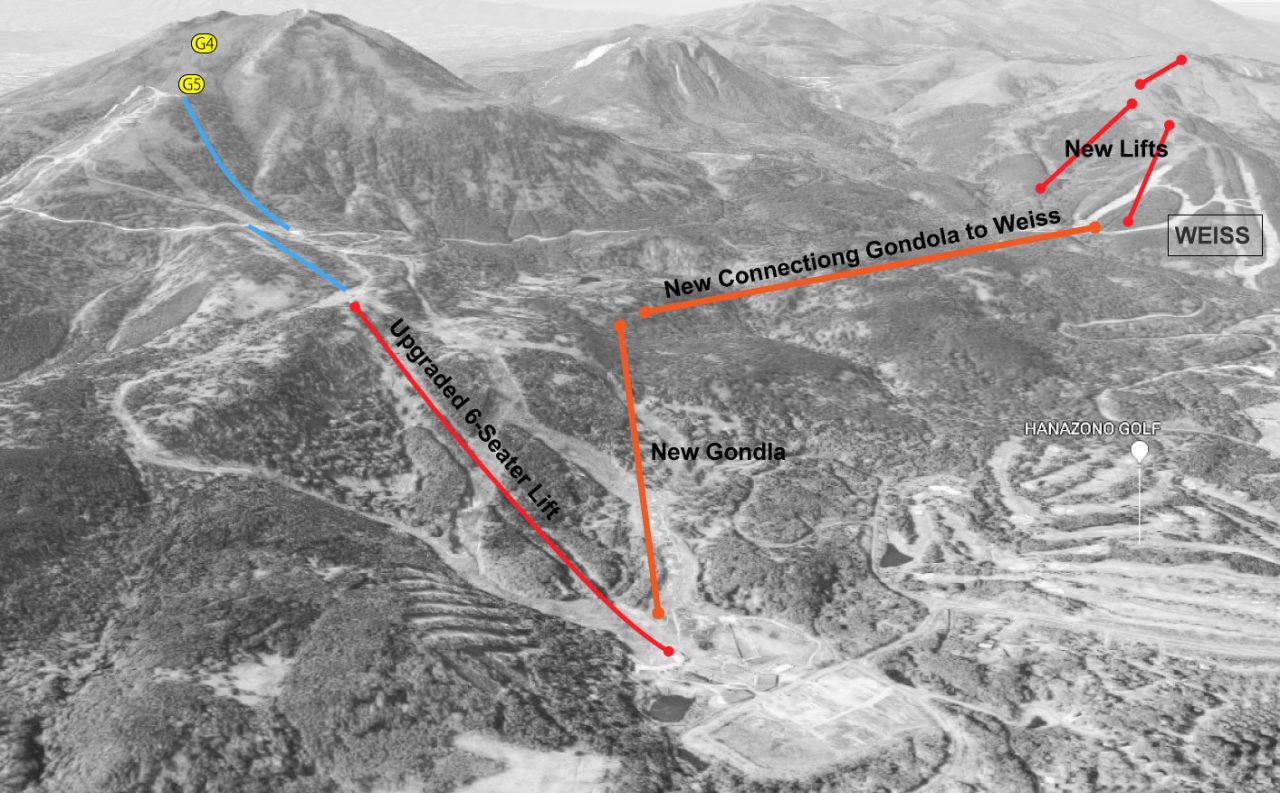
Incidentally, PCPD (Pacific Century Premium Developments), a Hong Kong telecommunications major PCCW real estate development company, has previously announced that it will invest over 100 billion yen in the redevelopment of the HANAZONO area.
A ski lift (cableway business) is the same as railway business, and it is difficult to make a profit and loss by transportation alone. Railway operators, as a set, develop real estate along the line without exception. Similarly, PCPD can invest heavily in gondola and lift because it is part of a comprehensive resort business that includes accommodation services.
Can JRT re-build the lift?
According to the income and expenditure plan submitted by JRT to Rankoshi-cho, the lesson usage from the 2018 to the 2020 season is 6 million yen and the powder tour is 94 million yen. The total is 100 million yen per year.
In brief, less than 90% of sales are lesson income.
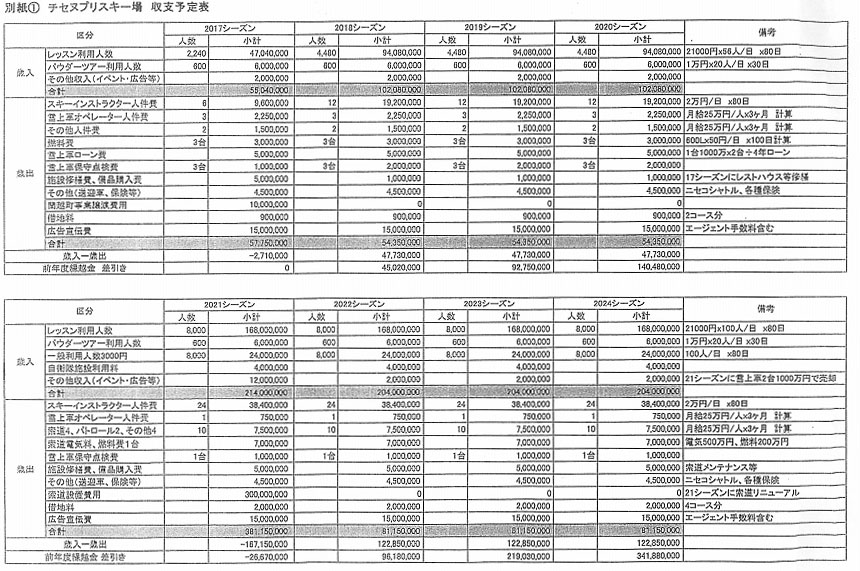
JRT showed lessons using CAT as the main source of revenue, but no lessons are taking place in the 2019-20 season. Since their plan expects stable sales for it, it is likely to be a beginner lesson in high demand. However, the slopes of Chisenupuri are unsuitable for beginner lessons, and there is great doubt as to whether the JRT was serious about conducting lessons. The reasons are as follows:
- Bad location
- Hirafu, Hanazono, Village, Annupuri and Moiwa each resort offer lessons. The location of the Chisenupuri is significantly inferior in comparison with them.
- Lessons need services other than lessons
- Other ski resorts have not only lesson but also an outdoor kids park. In addition, ancillary facilities and services such as rescue facilities and restaurants and indoor playland where attendants spend time are being enhanced year by year. In other words, skii lessons require the comprehensive power of the ski resort.
- Not suitable for beginner lessons, but intermediate lessons are possible. In fact, when the lift was run by the town, it was mainly used as a ski education slope for elementary and junior high schools in Rankoshi Town. Of course, the use as a place for school education, which is not expected to generate much profit, did not support the management of ski lift.
- Bad slope condition for lessons
- Lessons require constant gradual slopes. The slope of the slope at the Chisenupuri ski slope is not only gradual but also constant. Further, the main slope is inclined downward to the right, which is not preferable for practice by repetition.
- Need PistenBully and snow operation
- CAT skis don’t need snow operations. However, ski lessons require to maitain ski slopes.
Future Action
As indicated earlier, the ski lift (cableway business) is the same as the railway business, and it is difficult to make a profit and loss by transport alone. In other words, businesses that do not have lodging and real estate businesses that will increase revenue due to the resumption of lift will not make a large investment in reopening the lift.
Therefore, if Rankoshi-cho wanted to resume the lift, a means other than “sale of facilities” was necessary. However, Rankoshi has decided to “sell the facility” while receiving a signature to continue the ski resort. Moreover, despite the clear upturn in the local economy due to the increase in skiers, the price has been reduced to one-fifth of the original price and rushed to sell.
Rankoshi Town did not specify the resumption of lift in the sale conditions, and the staff was less aware of the resumption of lift. Then, the proposals of companies that applied for purchase were all CAT skiing. The business plan submitted by JRT to Rankoshi-cho states that “5. Aim to reopen the cableway by attracting stable customers and realizing accommodation facilities around Chisenupuri (21 season target)”. In addition, the income and expenditure schedule includes 300 million yen as lift equipment costs in the 2021 season.
Regarding the profit forecast of lessons in the JRT income and expenditure schedule. To the author, it looks sloppy. As mentioned earlier, Chisenupuri is not suitable for high-priced beginner lessons in the first place. On the other hand, the earnings forecast for CAT skis (number of people using powder tours) seems to be extremely low. This is an evaluation based on the actual data of Iwanai CAT skis.
The following is a small conjecture by the author. Leasing the site of a ski slopes are a concession that allows them to use the national park. And if the contract with Rankoshi-cho does not promise to restart the ski lift, if they keep saying “JRT postponed it because the profit did not rise as expected”, it does not mean that they lied even if they did not restart the lift.
Perhaps JRT didn’t intend to operate lessons for beginners. Perhaps they just wanted to improve the appearance at the time of selection by making the school a pillar when making a proposal to Rankoshi-cho.
The operation of the slopes is completely different from the proposal, so Rankoshi-cho should complain. However, in the interview on May 17, 2020, Mayor Hideyuki Kon (then deputy mayor) and Deputy Mayor Isao Yamauchi (then general affairs section manager) of Rankoshi-cho just only defended JRT.
FYI, at the time of selection, a committee was organized to consider the disposal / operation of ski resorts, with Hideyuki Kim as chairman and Isao Yamauchi as vice chairman. The sale of ski resort facilities and the treatment of lease rights were all drafted by Isao Yamauchi, and Hideyuki Kim approved it. In other words, they were in a position to control everything, except for Congressional approval, which tends to fall into a formal process.
Who wants exclusive CAT skiing?
No reason to continue land leasing without restart of lift
Rankoshi-cho did not make the resumption of the lift a condition of the sales contract. On the other hand, Hokkaido, which rents the site, clearly states that “Aiming for an early resumption (of the lift)” in Article 3 of the contract document.

Since “early” is abstract, legal binding is low, but better than nothing. In the first place, since the site of the ski slopes is in the quasi-national park, renting is extremely difficult. The leasing is just continuing becauseof the lift. Nobody cannot rent the site for CAT skiing.
If JRT can prove the failure of the plan shown in the income and expenditure plan table, it may be possible to exclude JRT from the aspect of the lease contract as insufficient qualities to succeed the lease right.
The risk that safety is an excuse
Comparison with ”Niseko rules”
In Japan, everything is allowed for safety reasons. An example of a ski resort which once used ropes throughout the course to constrain skiers. The cause is “ensuring safety”. The degree of safety and user convenience are not discussed, and management has been carried out to minimize the risk on the management side.
“Niseko Rules” was born to respect the freedom of users rather than such an operator-oriented approach. It was an attempt to honor the user’s spontaneity, not to force unreasonable regulation in the name of cause.
And “Niseko Rules” had cut through the red tape, have been evaluated by users and be a factor in reflecting the current Niseko.
Unhappy Chisenupri Ski Slopes
The exclusive operation of Chisenupuri Ski Resort by JRT is in contrast to “Niseko Rules”. If the purpose of the exclusive operation of JRT is “ensuring safety”, even if the excluded side complains to the officials in Rankoshi and Hokkaido, they will not be dealt with.
Anyway, the JRT method is not acceptable as Rankoshi resident. From the moral standpoint of selling the facility, Rankoshi-cho should hear from the JRT about the resumption and exclusive operation of the lift and tell the townspeople.
Chisenupri Ski Slopes has a history that can be said to be the origin of mountain skiing, and there is the uniqueness that a good quality hot spring is adjacent to the slopes, and there are fans who grieve their closure.
It is very unfortunate that users and other tour operators are dissatisfied with ski resort operators.

